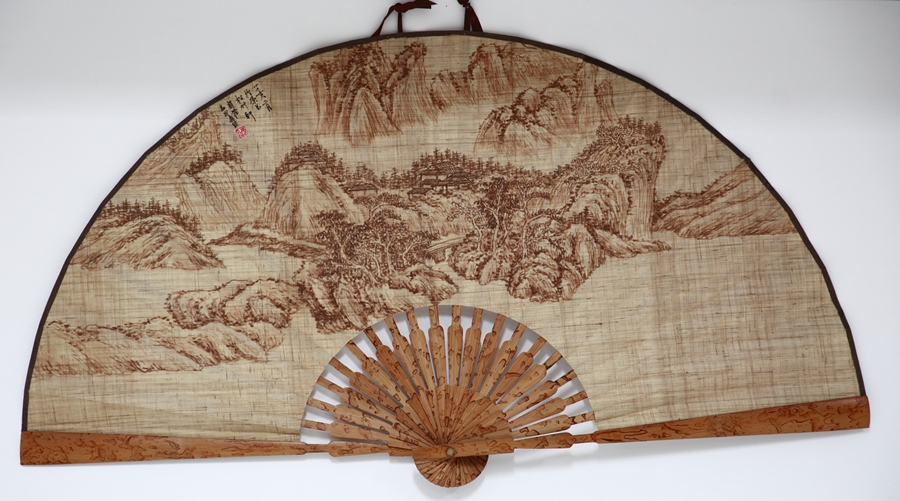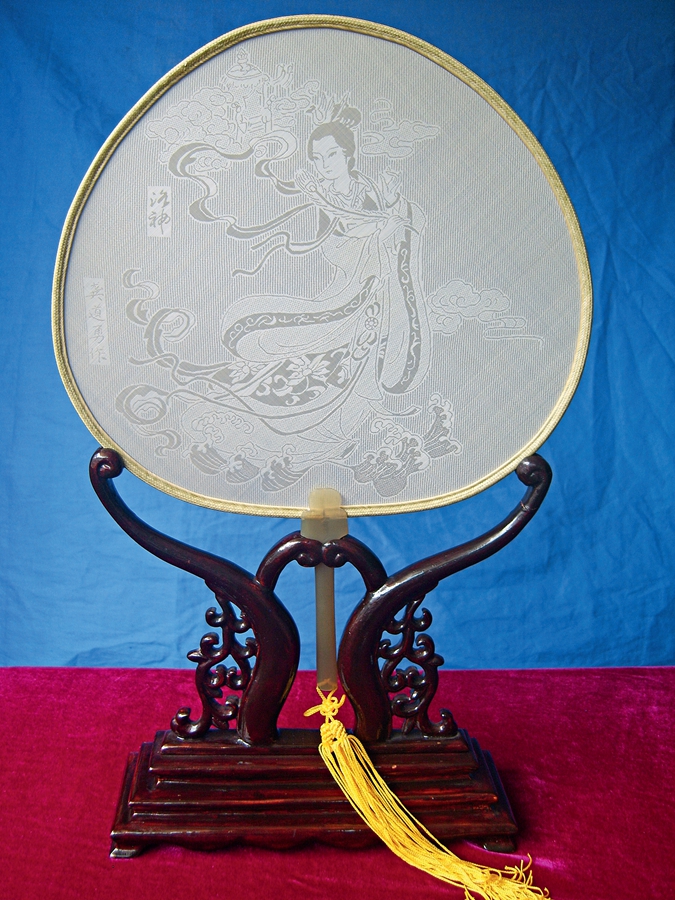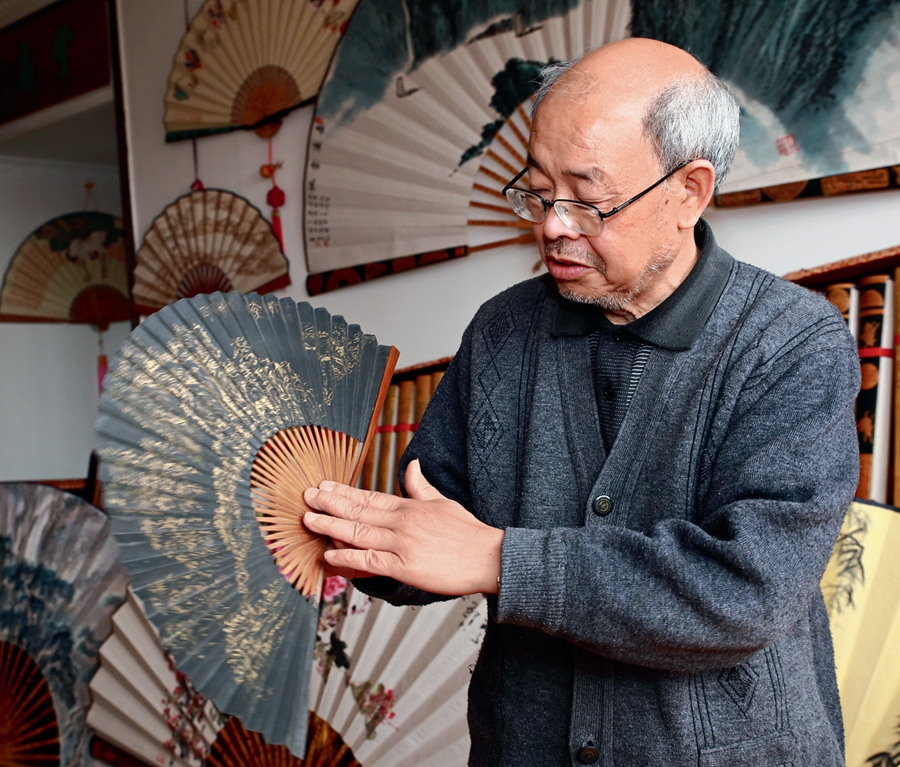THERE are many anecdotes and tales about Chinese fans in historical records, novels, and legends. Some notable ones are the goose-feather fan held by Zhuge Liang, a famous military strategist during the Three Kingdoms Period (220-280), and the banana leaf fan that belongs to Princess Iron Fan, a fictional character from the classic novel Journey to the West. In many ancient paintings, most alluring beauties can be seen holding a circular fan in their hands. These examples reflect the cultural significance of Chinese fans. Even today, many people prefer holding a fan while wearing traditional Chinese clothes as a decoration. Over millennia, Chinese fans have evolved from an accessory for daily use to an artifact that incorporates the essence of various forms of arts and crafts, as well as folk culture.
The Fan Culture
Fans are popular among all segments of the Chinese people, from emperors and men of letters to ordinary people. Different kinds of fans served as indicators of status. For example, men of letters preferred folding fans; military strategists and Taoist priests preferred feather fans; girls of noble families liked circular fans while ordinary people usually used palm leaf fans.

A traditional Rongchang folding fan made of local ramie fabric.
The reason fans evolved from an accessory to an artwork is largely related to men of letters, who liked to use fans as canvases for artwork or for writing poetry, and presented them to their friends as a commemorative item. Therefore, they pursued better decoration of fans, eventually leading to fans emerging as artwork that combined various forms of arts such as poems, calligraphy, painting, engraving, and embroidery.
It has been popular to draw fans or write poems about fans, and paint or write on paper fans. There is a story about Wang Xizhi (303-361), who is best known for his mastery of Chinese calligraphy. He is regarded as one of the greatest Chinese calligraphers in history and his works have exerted a far-reaching influence on future generations. However, it is a pity his works were lost and only the replicas in the Tang Dynasty (618-907) have been preserved till today. It is said that once Wang saw an elderly lady selling fans. As it was the end of the summer, business was not so good. She looked very upset, so Wang decided to help her. He wrote a few characters on each fan and told the old woman to raise the price. On seeing calligraphy by Wang on those fans, people all competed to buy them, which then sold out very quickly.
It has been popular to paint on fans since the Tang Dynasty, and it became even more popular during the Song and Yuan dynasties (960-1368). Artwork on fans is also a unique genre of Chinese painting. As space is limited, the painters need to pay close attention to the composition in the half-circle fan, so the creation of elegant and unique imagery or scenery requires extra skill and precision.
For thousands of years, the Chinese people never stopped innovating fan design and manufacturing, adopting different materials such as bamboo, palm tree leaves, wood, paper, feather, silk, bone, and sandalwood, and made fans of various shapes, such as circular, square, oval, flower petals, or hexagonal shapes.
Today, most people use electric fans and air conditioners for cooling, but in many places, especially among the elderly, still see a preference for traditional fans. Serenity comes to mind when picturing a golden hued summer evening as mothers fan their infants with the sounds of children running around echoing in the streets and women brandishing their fans in elegant dances in the public square.
Woven Bamboo Strip Fans
Fans made of woven bamboo strips from Sichuan Province were invented by the Gong family, thus named Gong Fans. With a history of over a century, the craftsmanship has been passed down to the fifth-generation heirs.

A Gong fan with an image of the Goddess of the Luohe River.
The creator was Gong Juewu, who displayed ingenuity since young age. Besides doing farm work, he made some accessories for daily use with bamboo strips and sold them to augment his income. Summer in Sichuan is scorching hot, so he made some bamboo fans which were popular among consumers. Once it took off, he just focused on the fan business. He saw some bamboo accessories bearing characters and patterns with auspicious meanings, which inspired him to use similar patterns and iconography on his fans. Through trial and error, he finally wove different patterns on his fans by utilizing the color variations of the two sides of bamboo strips. He continued to improve his works by making bamboo strips thinner, so the alternating patterns on the fans became more exquisite and intricate. Gong Fans are usually peach-shaped, with a width of 20-centimeters, a moso bamboo edge, a handle made of ox-bone or jade, and patterns of flowers on the fan surface.
Gong Yuzhang, son of Gong Juewu, is the second-generation heir of Gong Fans, who further improved upon and promoted their products. He managed to weave scenes of mountains and rivers, human figures, flowers and birds, fish and insects, as well as Chinese calligraphy. Once a businessman brought a picture to Gong, on which was a Chinese beauty with half her face hidden behind a transparent fan. The businessman wanted Gong to weave the scene to show the gradations. Gong, by utilizing the different thickness and density of weaving bamboo strips, vividly recreated the picture of the beauty behind the fan. Since then, his reputation skyrocketed. Some senior officials and eminent personages invited Gong to their houses to make his trademark fans for them.
To make a Gong fan involves a complicated process. A special kind of one-year-old local bamboo is selected as raw material, so that the bamboo strips processed with special tools are crystalline and a bit glossy. The material preparation is all about manual work, with the help of only a knife. The procedures include weaving the pattern and the edge, as well as gluing certain parts. The fan surface is as thin as a cicada’s wings, so it is very light. Many people would mistakenly assume it is made of cotton threads.
The crucial step is to make bamboo strips. The thinner the strips, the clearer and more life-like the patterns are. Gong Yuzhang invented a set of tools, with which he can make hair-thin bamboo strips, and feather-like bamboo strips that can be used to make fluffy sparrows at different ages. Sometimes he poked dots on the thin strips to form human eyebrows. He also used different colors of bamboo strips to deal with lighting and shade. The pictures on the fans include natural scenery, birds, animals, and flowers, all look vivid and life-like.

Chen Zifu, who was born into a fan-making family in Rongchang, promotes the traditional technique of making Rongchang folding fans.
Gong Daoyong, the fourth-generation inheritor, further shrank the thickness of bamboo strips from 0.025 millimeter to 0.01-0.015 millimeter and the width down by 30 percent. That means the bamboo strip is astoundingly one seventh of human hair. Thus the fan surface is even thinner and shows a semitransparent effect. Gong Daoyong’s daughter and niece are the fifth-generation inheritors of Gong Fans. They assert that the secret for keeping the Gong Fans popular is the constant striving for perfection.
In 2008, the craftsmanship of making Gong Fans was designated a national intangible cultural heritage.
Folding Fans
The folding fans made in Rongchang, a district of Chongqing Municipality, are popular around the country for their unique design, sophisticated craftsmanship, well-chosen raw materials, and light weight. Because Chongqing used to be under the administration of Sichuan Province, the Rongchang folding fans are also called Chuan Fans.
The history of Rongchang folding fans can be traced back to the Song Dynasty (960-1279). During Ming Emperor Yongle’s reign (1402-1424), the Rongchang fans were produced on a large scale, making Rongchang one of the three largest places for fan making in the country, with over 10,000 fine Rongchang fans being offered to imperial court every year. By the middle to late period of the Qing Dynasty (1644-1911), the development of Rongchang fans saw a switch from family-owned shops to professional production. In 1842, an industrial association for Rongchang fans was established, with aims to unite producers, expand production scale, and improve management and craftsmanship to boost the overall development of Rongchang fans. By the late Qing Dynasty, Rongchang had over 200 fan-making shops and more than 2,000 employees, with an annual output of four million folding fans.
The production of a Rongchang fan involves intense manual work of around 145 procedures, including dying, gluing, painting, engraving, and inlaying work.
However, with electric fans and air conditioners becoming popular, the traditional Rongchang folding fan faces obsolescence. In such a dilemma, Chen Zifu, who was born into a fan-making family in Rongchang, started to seek innovation.
Traditionally the surface of folding fans is made of paper or silk, but Chen chose local-made ramie fabric, which features simple but elegant colors and a little tough and rigid texture. Through trial and error and by borrowing techniques of mounting a painting on a frame for traditional Chinese calligraphy and paintings, Chen created his own ramie fabric fans, which turned out to be very popular on the market.
On the occasion that celebrated the 50th anniversary of the founding of the People’s Republic of China, Chen designed and made a set of commemorative fans, with various techniques adopted, such as pyrography, colored drawing, and incising. The set of fans have made the traditional Rongchang folding fans known to more people.
The new technique has brought Chen good fortune, yet he is willing to share it with his peers by inviting them to his studio and elaborating on the production process for them, as he wants more and more people to master the technique and increase the production of ramie fabric fans. He believes expanded production and an enriched variety of designs will surely boost the reputation of Rongchang folding fans, thus bringing about new development opportunities and growth prospects. In 2008, the craftsmanship of making Rongchang folding fan was added to the list of national intangible cultural heritage.
(Compiled by China Today)